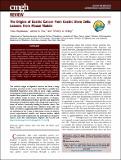The Origins of Gastric Cancer From Gastric Stem Cells: Lessons From Mouse Models
Author(s)
Hayakawa, Yoku; Fox, James G; Wang, Tim
Download1-s2.0-S2352345X17300310-main.pdf (936.2Kb)
PUBLISHER_CC
Publisher with Creative Commons License
Creative Commons Attribution
Terms of use
Metadata
Show full item recordAbstract
The cellular origin of digestive cancers has been a long-standing question in the cancer field. Mouse models have identified long-lived stem cells in most organ systems, including the luminal gastrointestinal tract, and numerous studies have pointed to tissue resident stem cells as the main cellular origin of cancer. During gastric carcinogenesis, chronic inflammation induces genetic and epigenetic alterations in long-lived stem cells, along with expansion of stem cell niches, eventually leading to invasive cancer. The gastric corpus and antrum have distinct stem cells and stem cell niches, suggesting differential regulation of cancer initiation at the 2 sites. In this short review, we discuss recent experimental models and human studies, which provide important insights into the pathogenesis of gastric cancer.
Date issued
2017-05Department
Massachusetts Institute of Technology. Department of Biological Engineering; Massachusetts Institute of Technology. Department of BiologyJournal
Cellular and Molecular Gastroenterology and Hepatology
Publisher
Elsevier BV
Citation
Hayakawa, Yoku, James G. Fox, and Timothy C. Wang. “The Origins of Gastric Cancer From Gastric Stem Cells: Lessons From Mouse Models.” Cellular and Molecular Gastroenterology and Hepatology 3, no. 3 (May 2017): 331–338.
Version: Final published version
ISSN
2352345X